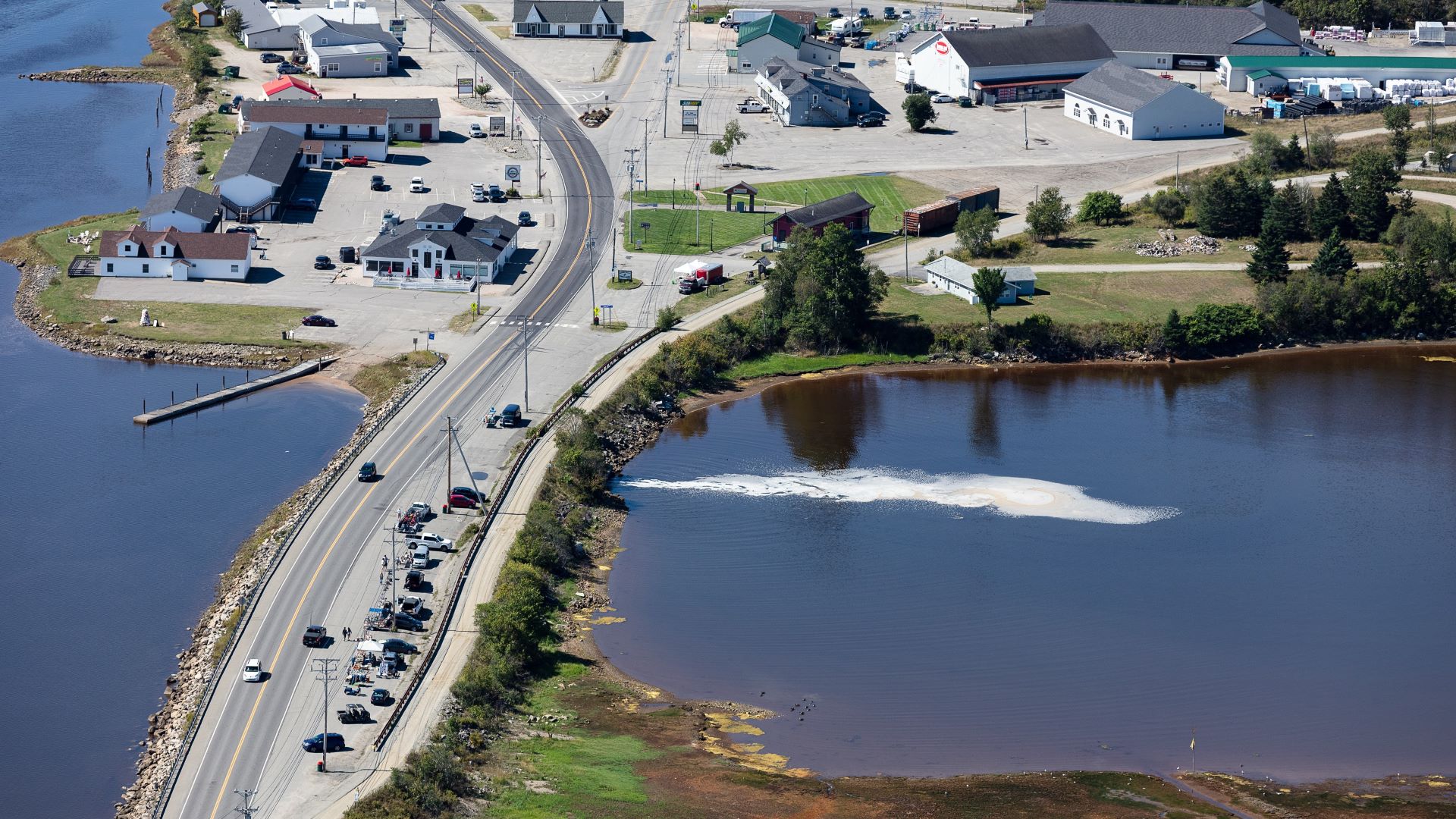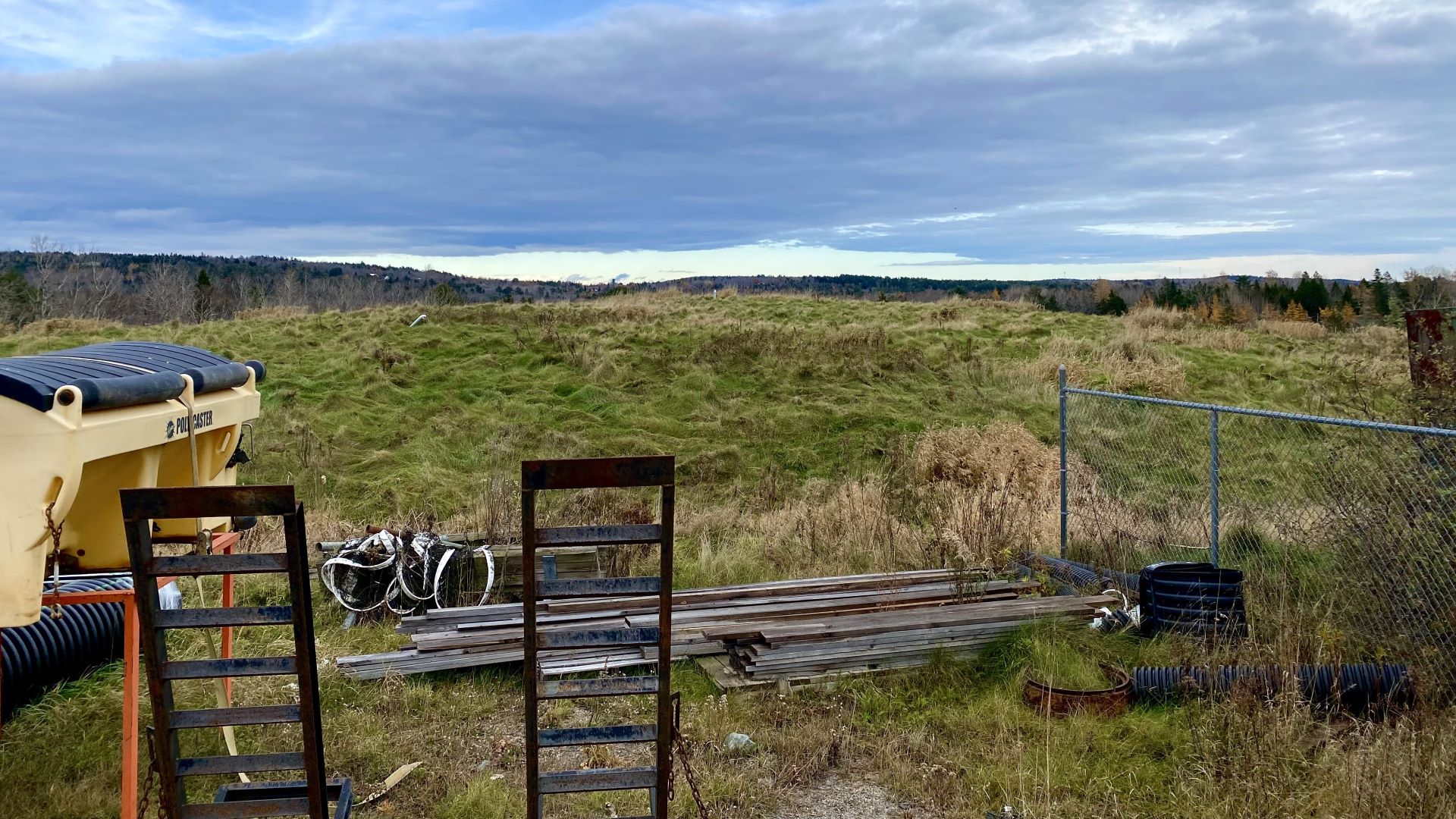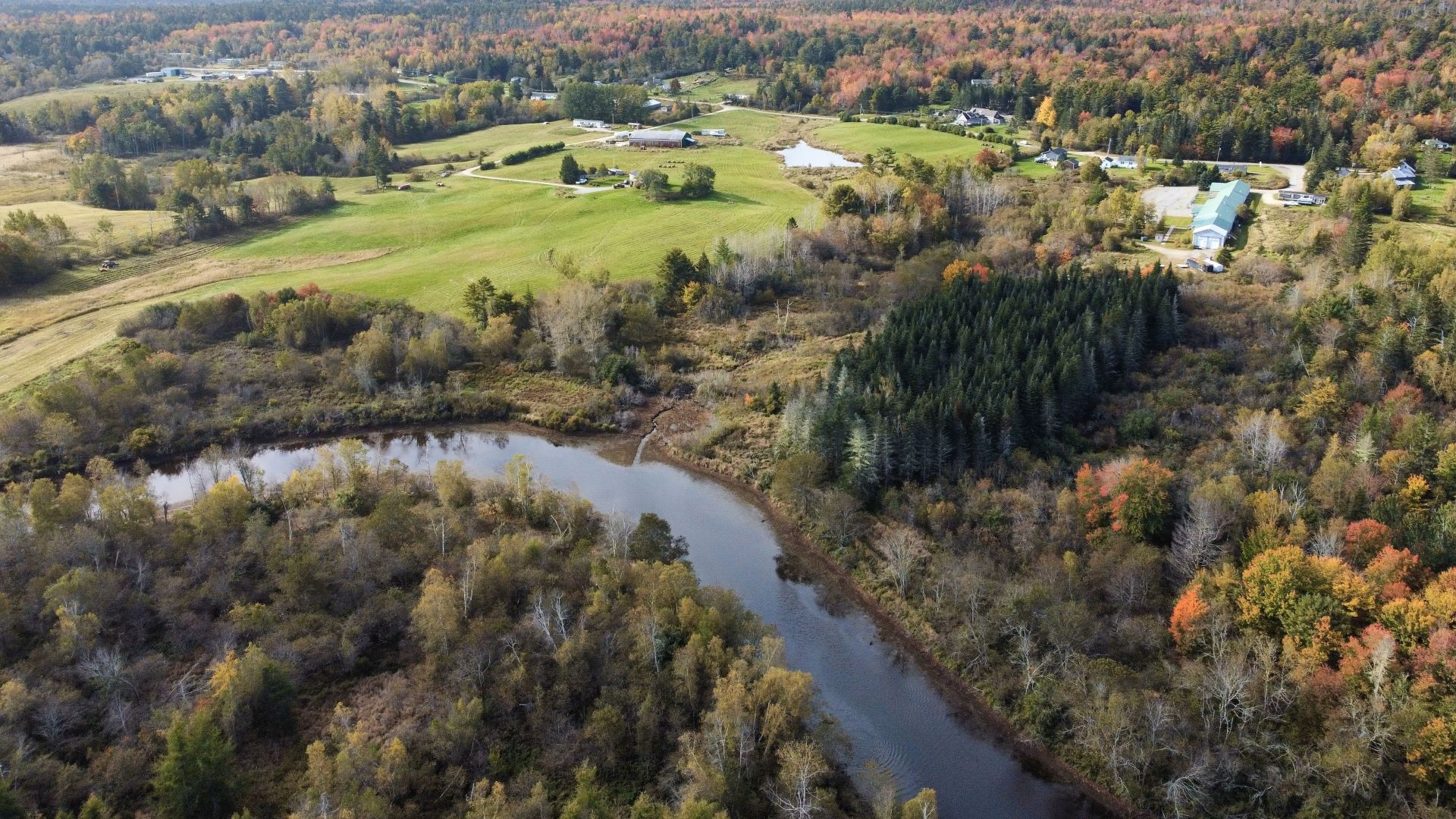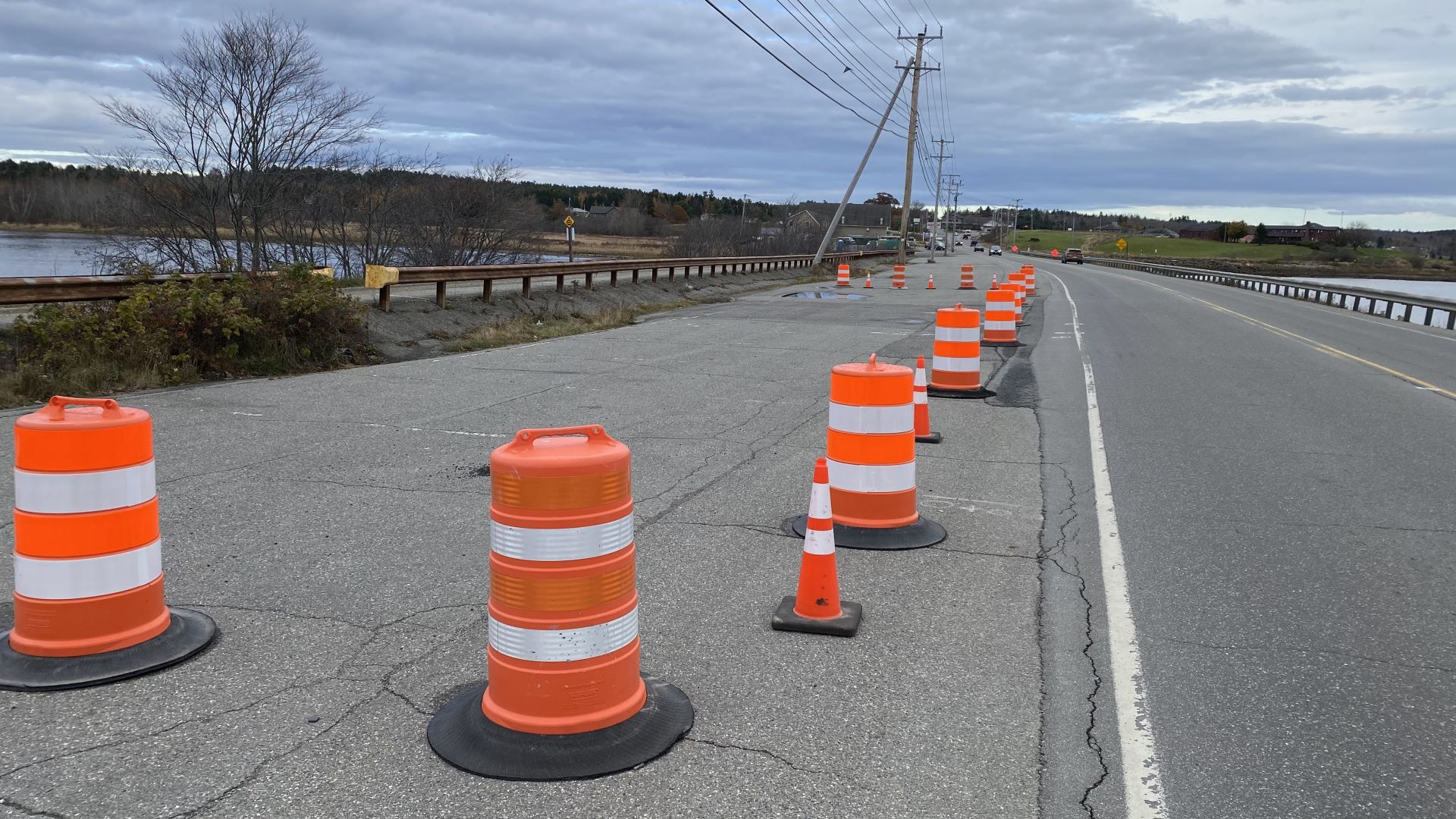Mother Nature took control after years of haggling over the best fix for Machias’ 150-year-old, rapidly deteriorating dike.
Last week, divers discovered increasing voids in the dike’s supporting structure, prompting the Maine Department of Transportation to announce Tuesday the existing dike will be totally closed in as soon as two weeks.
A temporary, modular steel bridge span will be installed atop the defunct dike — already partially blocked off by pylons and traffic barrels. Installation of this 60-foot temporary bridge is expected to begin after Thanksgiving and be completed by Christmas, according to Paul Merrill, director of communications for the Maine DOT.
Merrill said Route 1 will be closed at the bridge and several hundred feet out in either direction for about a week. The adjacent Sunrise Trail will remain open, Merrill said.
Although a temporary bridge was not included in any of the six dike replacement options considered, Merrill said MaineDOT was not surprised by the dike’s rapid decline.
“The conditions of the bridge are not deteriorating faster than we expected. We thought this would be a possibility, which is why we increased the frequency of inspections,” Merrill said.

Community leaders agree that the extreme measures are necessary.
Tora Johnson, a University of Maine at Machias geographer who has studied local sea rise and the dike since 2010, called the aging river crossing “enormously vulnerable.” Machias Town Manager Bill Kitchen agreed, saying band-aids won’t cut it.
“This will be a start over a structure since this thing is crumbling from inside,” Kitchen said.
In another surprising turn, MaineDOT also announced it reversed its decision regarding a permanent dike replacement.
After initially favoring replacement of the dike with a permanent bridge span, MaineDOT now says a replacement similar to the existing dike, with the continued use of fully gated culverts, is the best option. The decision, according to the press release, was based on feasibility studies, and 16 months of public and stakeholder input.
As many as 54 Middle River properties, roughly 400 acres, could have been inundated by Machias Bay waters if a permanent bridge replacement was built. The replacement with a new bridge allowing water to flow freely underneath would literally have opened the floodgates.
The DOT’s reversal was welcome news to property owners such as Marshfield residents Stephanie and Joey Wood, who have lived along the Middle River for 30 years. More than 1,000 bales of tidal hay are gleaned along their property’s shore each year by blueberry farmers, hay that a bridge would put underwater.
But Stephanie Wood also worries about leaching from the abandoned Marshfield landfill.
“The report on the landfill says there would be no toxins and toxic chemicals in there but that would be near impossible to imagine,” Wood said. “I mean, I was here as a kid and saw the stuff that was buried there.”
Merrill said the landfill report was one of several contributing factors in MaineDOT’s decision to change its preferred option. Another factor that had to be considered was preservation of the rail bed for potential future use, as mandated under Maine’s State Railroad Preservation Act.
The decisions were also made amid rising costs. Last year the price was roughly $22 million for a dike with culverts and $30 million for a bridge. According to Merrill, the dike option would be approximately $25 million if it were done today, although he said that could change based on outside economic factors.
With permitting, regulatory issues and the possibility of legal challenges to the department’s decision, construction for a permanent new dike could be years away.

Critics of the dike option say it fails to address critical issues such as tidal restoration, preservation of diminishing wetlands, better fish passage and most importantly, flooding.
Marine biologists favor a bridge span that would allow the free flow of water through the Machias River estuary, restoring the aquatic biome to what it was like before the dike was built in the Civil War era.
MaineDOT’s about-face is a major setback for environmental groups fighting for a bridge, among them the Downeast Salmon Federation, Maine Coast Heritage Trust and National Oceanic and Atmospheric Administration (NOAA).
Charlie Foster is associate director for the East Machias-based Downeast Salmon Federation, a nonprofit working to restore hatcheries, shore land and habitat. Foster said his concern is not just about the fish. He points to major coastal floods and rising tides frequently washing saltwater and debris onto the deck of the dike — evidence of rising seas caused by climate change.
“And you know, we’re talking about U.S. Route 1, the major transportation artery for this area of the state — so it’s a pretty important thing to get right,” Foster said.
Kitchen said even the crossing’s brief closure during construction of the temporary span will be a hassle for detoured passenger vehicles and trucks.
Although the DOT hasn’t identified the detours they will be designating, Kitchen said there are really only two good options. One would be from the south side of Machias, via Machiasport to Rim Road into East Machias. The other would be to take Route 192 in Marshfield to Ridge Road, then Hadley Lake Road onto Route 1 north of the dike.
Especially concerning, Kitchen said, will be challenges for first responders. Still, he knows the current dike has to go.
Foster and others say the risk isn’t only to the dike and roadway. Local and federal scientists say an increasingly urgent concern is possible flooding and destruction of properties in downtown Machias — the Washington County seat — as sea levels continue to rise.
Some businesses, such as Living Innovations, have moved from the river’s edge, while others, including Helen’s Restaurant and Machias Savings Bank, have built or rebuilt along the river but on a higher grade, according to Johnson, the UMM social scientist and geographer.
Johnson said the science can’t be ignored. She said there have been five 100-year floods in the past six years. Johnson points out that some of the culverts in the current dike do not function, inadvertently mitigating some of the waters that might otherwise flood the town. She said it’s proof some of the culverts need to have open gates.
Johnson said MaineDOT’s dramatic reversal is unwise and unnecessary. She said one alternative called for a dike with some open and some closed culverts that would provide a good deal of flood protection without as much impact on landowners.
“It was really right there — right there!” Johnson said. “What they’ve done instead is say, you win, and you lose, which means everyone loses. That’s not how you do public policy.”

Johnson, who begins a new position in January with the Sunrise Economic Council as co-director of sustainable prosperity, is part of a group of stakeholders called the Machias Bay Resilience Project.
They meet regularly with state officials to hash out issues related to the dike and five other water management projects. Items certain to top the agenda at their next meeting Wednesday are the MaineDOT’s new preferred option, as well as how the temporary bridge will impact the town and the region.
The temporary bridge is a prefabricated, six-section steel structure engineered by Mabey Bridge, a United Kingdom-based company. Merrill from MaineDOT said the span will keep traffic flowing and the Sunrise Trail open until a permanent replacement for the dike can be designed, reviewed, permitted, then constructed.
But the temporary fix — which some officials predict will last at least two years — does not accommodate parking or vendor space on the bridge.
“Once the temporary bridge is in place, there will be no shoulder access on either side of the temporary bridge,” Merrill said in a written statement to The Maine Monitor. “Our intent is to always keep the Sunrise Trail open to pedestrians and bicyclists.”
Kitchen, the Machias town manager, said the loss of vendor access along the crossing, an historic practice and a tourism draw during the summer, will have a huge impact on the culture and economy of the region.
“Once this thing gets put in, it will be in place for years and I’m not sure everybody’s getting that,” said Kitchen. “It’s not coming out until we build a new bridge.”
According to its press release, MaineDOT will prepare a draft environmental assessment of the gated culvert alternative under the National Environmental Policy Act. The department intends to hold a public meeting on the draft assessment in early 2024, and anticipates the project will enter the design phase by this time next year.
Additional project information is available on the state’s website.







